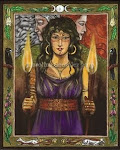 |
| Sacred dance in ancient Egypt |
Sacred dance was prevalent all over the ancient world and it is a very ancient form of worship. Evidence of sacred dance has been found painted on cave walls dating back to about 10,000 + years ago. Dance can transport the soul to another dimension and guide the dancer into a trance. It's no wonder that sacred dance was a part of so many cultures around the world. Sacred dance was performed in the ancient world during temple ceremonies, rites of passage, funerary ceremonies and marriage among many other events. It was used as a way to connect with the deities through movement and trance. Sacred dance was also seen as an emotional release for the body.
Dance in ancient Egypt was very popular and the first evidence of it dates back to about 4000 BCE. Paintings on pottery and temple walls show scenes from different ceremonies with women, men and gods dancing. The Goddess Hathor was known as the Mistress of Dance and her priestesses would perform sacred temple dances in her honor. Ancient Egyptian dance was performed for magical purposes, to induce trance and to honor the gods among many other things. Egyptian dancers used musical instruments such as rattles or sistra, tambourines, drums, bells, flutes and a variety of other instruments to enhance their dance. Some dancers were said to be nude while others were said to have worn loincloths, transparent robes, jewelry, headdresses and makeup.
Sacred dance in India was based on stories of Indian mythology and was seen as the dance form of the stories. It was also seen as a way to communicate with the gods. Sacred dance in India is called Indian Classical Dance and there are eight different forms. These are Bharata Natyam, Kuchipudi, Mohiniyattam, Sattriya, Odissi, Manipuri, Kathakali and Kathak. Sacred dance was performed by temple dancers who were women that dedicated their lives to dance and were known as Devadasies. During the dances the women would do different postures and poses as well as hand poses called mudras. The dancers would wear intricate and beautiful outfits that consisted of silks, bright jewels, a jasmine garland in their hair and little bells on their feet.
In ancient Greece there were many forms of dance. Two of these forms of dance were known as Apollonian and Dionysian. The Apollonian dance style was said to be slow and thoughtful and was performed during religious ceremonies, marriages and funerary rites. The Dionysian dance style was ecstatic, passionate and filled with desire. It seems that in Ancient Greece dance was part of the education of all people. In Ancient Rome dance was typically practiced during religious rites.
Dance can be incorporated into any of your own personal rituals in any fashion. Adding ecstatic dance to a ritual will greatly help with achieving a trance-like state. There is no right or wrong way to dance. Just slowly allow your body to move with the rhythm of the music. Trust your body. Once you get a good rhythm going allow your intuition to guide you into the type of dance you need. You will feel the energy rising. When you are finished with your ritual dance you will feel it in your body too. You have expended the energy for your rituals intent.
Personally for me incorporating dance into my rituals has brought me closer to my goddess and given me a deeper spiritual practice. If you have never danced in ritual you must try it! Such a freeing feeling!
Picture courtesy of Tour Egypt



No comments:
Post a Comment
Thank you so much for your comment! I appreciate your support! Many blessings to you )O(